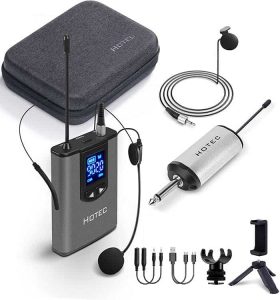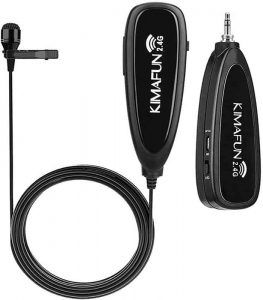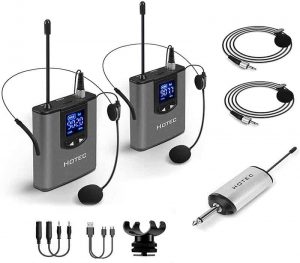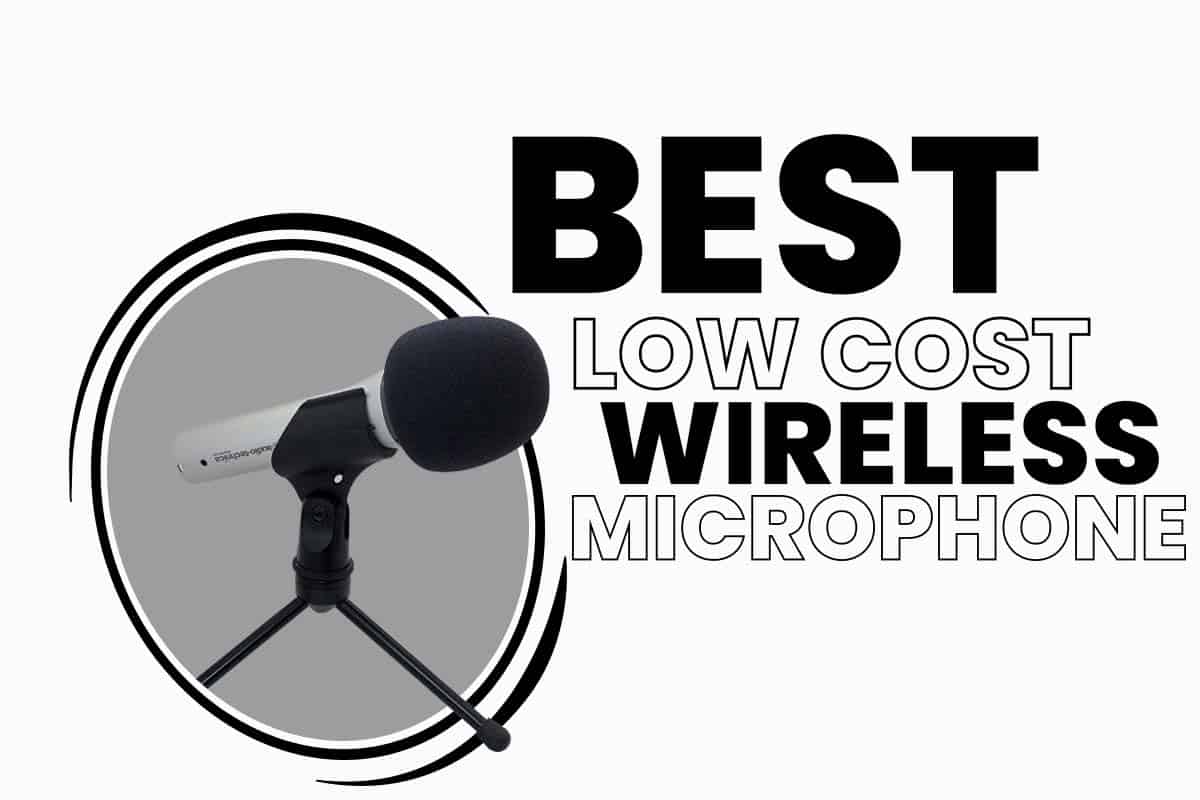
You don’t have to break your bank account on a wireless mic system; look at our best low cost wireless microphone review.
Wireless microphones offer musicians, public speakers, teachers, and worship space sun deniable benefits. Unlike their rival counterparts wired microphones, wireless systems are easy to set up and allow free movement on stage unrestricted by cables.
With the ever-growing technology and innovations, they are various choices that fit specific situations and needs. You can’t miss out on a wireless mic that meets your demands.
While many brands claim that they produce the best all-around wireless mic systems, some have chosen a targeted approach while advertising their specs.
We aim at giving you all the necessary information you need to make an informed purchase. Let’s get started with a comparison table as a quick overview of the top 3 wireless microphone systems on our list for those in a hurry.
Table could not be displayed.What Are Important Things To Know Before Purchasing A Wireless Microphone?
Wireless microphone systems have three major components; microphone, transmitter, and receiver.
Microphone
There are three types of microphones; handheld, headset, and lavalier. A wireless system will feature any of these three types of microphones.
- Handheld microphones: They closely resemble the wired microphones, except they have a thicker handle since it’s used to house the battery and the transmitter’s antenna. Most wireless handheld microphones are designed with a cardioid pattern that makes them less receptive to feedback on stage.
- Lavalier microphones: They are also referred to as clip-on microphones. They are commonly worn on the lapel; this makes them perfect for presenters who want to be hands-free. Due to their tiny sizes, the clip-on mics come with a separate transmitter housed in a ‘bodypack’ and is worn on the belt. The transmitter connects to the lavalier via a tiny cable easily hidden under clothes.
- Headsets microphones: Also known as ear set, they are worn around the back of the neck or over the ears. They come in different sizes and looks and still offer the freedom of hands being free. Most headset mics come with a separate bodypack transmitter, but they are a few that come with an inbuilt transmitter at the neckband region.
Transmitters
As you might have already guessed, transmitters convert the audio signals from the microphone into a signal that a receiver can pick up and then transmits it wirelessly to the receiver.
Receivers
They are used to convert the digital signal from the transmitters back into audio signals that can be heard and sent through the wire to your power amp. Receivers can either be a single or multi-channel system.
Frequency bands
There are two types of frequency bands that wireless systems use: ultra-high frequency bands (UHF) and very high-frequency bands (VHF).
Before we go deeper into the subject, what is a frequency band? It’s hard to talk about wireless systems without mentioning the frequency band.
Frequency bands are basically intervals in the frequency domain, between the lower frequency and the upper frequency.
To better illustrate, here is an example; the frequency band used by wireless guitars is UHF 470-608MHz. 470MHz is the lower boundary, while 608MHz is the upper boundary. The entire region between the lower and upper boundary is called the frequency band.
It’s important to note that the entire frequency spectrum operates between 30 kHz to 300 GHz.
Most wireless microphone systems operate in the UHF band of 450-952 MHz, but a few operate in the VHF band of 49-216MHz.
One advantage of VHF systems is that they are pocket friendly, although they have few channels you can work with.
The best frequency band for a wireless microphone is the 2.4GHz because it is globally available and unlicensed.
Ten Coolest Reviews For Best Low Cost Wireless Microphone
1. Pyle Channel Microphone System-VHF Fixed Dual Frequency

Pyle Channel Microphone System is a black cordless microphone system with a dual-frequency channel with a broad audio response range.
Specifications
- Brand: Pyle
- Connections: Wireless
- Compatible with: PA systems, Amplifiers, Mixers, Karaoke
- Power source: Battery
- Weight: 8 Pounds
Features
Pyle channel microphone system is a wireless set with two handheld dynamic transmitter mics that have ultra-long distance connection, up to 165f.
This makes it awesome to be used with large crowds since it also has a high frequency range of 174~216MHz. The audio quality of this wireless mic system is unmatched, thanks to the high signal over noise ratio performance.
Two handheld dynamic transmitter mics are used when moving around, both indoors or outdoors. Each mic is independent so that the volumes can be adjusted simultaneously and simultaneously used by two other people.
It has a receiver base that makes it compatible with PA systems and even karaoke machines. There is a 1/4" audio connector jack for connecting the devices to it. The receiver also has an on and off switch.
2. BONAOK Bluetooth Karaoke Wireless Microphone

This handheld karaoke microphone is arguably the best inexpensive wireless microphone. It will make Christmas, birthday, and even home or office parties more fun. It's available in different colors, including rose gold, blue, and silver, just to mention a few.
Specifications
- Brand: BONAOK
- Power source: battery
- Connection: Bluetooth and USB
- Hardware platform: PC and smartphone
Features
The BONAOK is solidly built with sturdy metals you will only see in high-end microphones. It will serve you for an extended period of time.
The working time of the BONAOK Bluetooth Karaoke Wireless Microphone is up to 5-10 hours; thanks to the 2600mAh rechargeable multi-protect lithium battery (18650).
It is compatible with many devices such as PCs and all smartphones; it is also compatible with apps like YouTube.
It uses both an audio cable and Bluetooth connection. The Bluetooth connecting distance is 10m and can also support SD cards.
It is easy to use since you only need to open the singing app once you connect it to a preferred device. Its unique design guarantees you a firm and comfortable grip. Its multifunctional buttons make it quick to change models and adjust the volume.
3. Hotec UHF Dual Wireless Microphone System

For a better audio system when capturing a live performance, interview, or shooting videos, you should get a high-quality wireless lavalier microphone that will deliver crystal clear sound. The Hotec UHF dual wireless mic will get you looking no further.
Specifications
- Brand: Hotec
- Polar pattern: Cardioid omnidirectional.
- Frequency range: 902-928MHz
- Connector type: 6.35mm jack
- Power source: battery
- Hardware platform: camera and smartphone
Feature
This wireless unit comes with an adapter and a headphone splitter, to allow you to connect it with your smartphone, be it an OS or regular android phone, for recording on YouTube.
The sound transmission is clear and of high-quality, without echo and distortion, hence suitable for live performance, studio recordings, and sound reinforcement.
This wireless microphone system is easy to set up; a rechargeable battery powers both the transmitter and the receiver, you just need to plug the mic into the transmitter, and you are ready to go.
This wireless microphone system has a multi-use application hence suitable for karaoke, party, weddings, church, etc.
4. KIMAFUN 2.4G Wireless Lavalier Microphone G130

The KIMAFUN 2.45G wireless lavalier microphone G130 is excellent for public speaking. It has decent performance credentials.
It can transmit up to around 30-50 meters in range. I can't quite think why you will want to be that far away from the receiver, but it's good to know it has that kind of range.
Specifications
- Brand: KIMAFUN
- Weight: 0.8 Ounces
- G130 color
- Material: Metal
- Power source: battery
Features
This wireless microphone system has made long-distance wireless transmission easy as it can transfer between 100-160 feet in an open field. Its portability and ability to automatically connect once turned on makes this even better.
You can use the KIMAFUN 2.4G Wireless Lavalier Microphone G130 microphone for 6-8 hours, and the charging time for the battery is 3-4 hours. You get to enjoy stable and robust signal strength for longer hours.
The microphone comes with a plug adapter for power amplifiers, audio mixers, and even outdoor speakers; USB sound adaptor for PCs and MAC; a 3.5mm (1/8”) plug for android phones, iPhones, and DSLR cameras.
5. Portable VHF Wireless Microphone System

The PDWM2140 Wireless Mic System from Pyle Pro is a two-person system that allows one person to use the bodypack transmitter with either the lavalier or headset mic.’
In contrast, a second person uses a handheld microphone. The system is suitable for various speech and vocal applications, including classroom instruction and conference rooms.
Specifications
- Brand: Pyle
- Polar pattern: Unidirectional
- signal to noise ratio: 40 dB
- Weight: 0.81 ounces
Features
It has a ¼” jack for connecting to devices such as; amplifiers, stereos, audio processors, and a DJ mixer. You can move about with the cordless microphone as it has a compelling wireless range of up to 100 feet.
This Portable VHF Wireless unit has a high signal over noise ratio for precise, and clear sound reproduction, unlike low-grade units.
Easy to use features and also includes an acoustic pop filter-making karaoke more fun. A 2AA battery powers the microphone while the receiver is by a 1AA battery. Fie extended wireless range; the receiver features an integrated antenna.
6. NASUM Dual Wireless Headset Lavalier Mic

NASUM Dual Wireless Lavalier Mic is another best low cost wireless microphone system that can be used for vlogs, churches, teaching, interview, video recording, YouTube, and podcasts.
Specifications
- Brand: NASUM
- Connections: USB
- Compatible with: Laptop, PC, Tablet, Camera, Smartphone
- Power source: Corded Electric, Battery
Feature
This wireless Headset Lavalier Mic provides a stable and robust UHF signal of up to a distance of 30-100 feet operating range. You can also change frequencies in case there is interference.
The mic system uses a patented technology of high-speed sound transmission, and it produces clear sound with no feedback and low distortion.
More so, each microphone unit features a distinctive ID code that allows them to be used at the same time using the 32 selectable frequencies.
You can use this multiple wireless microphones simultaneously, and it is compatible with many devices. For amplifiers, mixers, PA systems, and recorders, you get a ¼" mic jack.
For iPhones, iPads, or android phones, there is a 1/8" TRRS jack and a fit MIC IN DV/SLR camera.
7. Hotec Wireless System with Dual Headset Microphone

The package also includes one mini rechargeable receiver; there is also a ¼" output. You can use this microphone set for all types of live performances.
Specifications
- Brand: Hotec
- Weight: 0.01 Ounces
- Polar pattern: Unidirectional
- frequency range: 902-928MHz
Features
With an operating range up to 100ft, you can be sure to get a clear sound that's of high quality. There is no signal distortion, and the selectable high-frequency range reduces the chances of interference.
It is compatible with karaoke machines, phones, laptops and DSLR cameras just to mention a few. Aw/ 1/4 MIC IN for voice amplifying is included together with a universal 1/4" plug.
The mic system also features a brightly lit LCD on the transmitter, which allows you to monitor battery level, frequency and volume. Adjusting the frequency and the volume is simple.
The working range if this unit complies with the FCC regulations and allows you to use multiple sets together with no interference.
8. KIMAFUN 2.4G Wireless Lavalier Microphone G102-3

This wireless microphone is ideal for teaching, weddings, presentations, and school plays—ideal for live performances.
A very comfortable Wireless Microphone: Suitable for Vlog, teaching, fitness instruction, public speech, trainers, stage performers, just to mention a few.
Specifications
- Brand: KIMAFUN
- Polar pattern: Unidirectional
- frequency range: 2400-2483 MHz
- Weight: 0.8 ounces
- Hardware platform: PC, tablet, camera, Smartphone
Features
They use rechargeable lithium batteries that can be used for 6-7 hours. These batteries are friendly to the environment and have a charge time of 3-4 hours. Charging can be quickly done with the dual USB cable.
The KIMAFUN 2.4G Wireless Lavalier Microphone G102-3 is compatible with amplifiers, mixers, PA systems, PCs, and smartphones. For laptops and PCs, you will require a USB sound card and two 3.5mm jack.
You have two options of using the microphone: as a general headset mic or remove the head bracket, where it is a handheld microphone. You get maximum comfort and freedom of movement.
The head of the microphone is made of durable, acid, and wear-resistant material. The hassle-free clip-on system is also made of lightweight material for the convenience of use.
9. YEOSEN Wireless Microphone

YEOSEN wireless microphone is best for small live events like church events and karaoke nights.
Specifications
- Brand: YEOSEN
- Connection: Bluetooth
- Weight: 1.77 pounds
- Frequency range: 0.05 kHz - 18 kHz
- Signal to noise ratio: 70 dB
Features
Its microphone or receiver will connect automatically through the UHF technology, and the signal range is up to 100 feet. The high-quality signal range is due to the latest upgraded chip technology system.
They are very sensitive and thus adopt new noise suppression technology to restore the warmest sound. Adjusting the echo and microphone volume is possible.
The mics features a control panel with easy to touch buttons and a small LCD display unit that displays what you input into the system.
This YEOSEN microphone is one of the easiest to use. After the first pairing, connections will always be automatic every time you open the channel.
The battery life is excellent. You can work with the YEOSEN Wireless Microphone for up to 10 hours when fully charged. It takes only 2-3 hours to charge fully. Its ¼” jack makes it compatible with many devices.
10. Hotec UHF Dual Wireless Microphone System- (H-K25)

It is compatible with mixers speakers and karaoke machines; this makes it the right choice for churches, sound reinforcement, studio recording, and conferences.
Specifications
- Polar pattern: Unidirectional pattern
- Frequency range: 902-928MHz
- Connections: XLR Connector
- Power source: rechargeable batteries
Features
You can operate this device up to a range of 100 feet. You can adjust the frequency in case there's any interference to get high-quality stage sound.
The body-pack receiver comes with two XLR individual outputs and one 1/4" microphone input of any of your sound system.
From the 64 selectable frequencies, each transmitter can use 32 frequencies, this makes the system less prone to electric interferences. You will enjoy high-quality sound transmission of up to 100 feet.
What To Look For In A Wireless Microphone?
The wireless mic you purchase will greatly depend on the application you have in mind. There are many options in the market, some with specific applications, while others are versatile.
Before you get that wireless mic, here are some things you might want to check first before making a purchase.
Microphone type
As mentioned earlier, there are mainly three types of microphones. You need to understand whether you need a handheld, headset, or clip-on microphone. Each type of this microphone is designed to suit a specific purpose.
Depending on what you intend to use the microphone for, it should be obvious the type of microphone you should get. If you need your hands to be free, headsets and lavalier microphones will do the trick.
In some cases, handheld microphones work best for presenters who find it difficult to compose themselves on stage. If you are not comfortable with large crowds, handheld mics will be excellent for you as they keep your hands busy and occupied, so you don’t look restless on stage.
The sound quality
What differentiates many wireless microphones is the quality of their sound. And this is even more important to singers and YouTubers. For you to please your audience, the quality of your audio needs to be top-notch.
There are plenty of mics, and not all were created the same. Some produce higher quality sound than others.
Here are few things to keep in mind when it comes to sound quality.
- Digital transmission produces excellent sound quality compared to analog transmission.
- 20Hz-20kHzystem frequency response is great.
- The best articulate mics are the condenser microphones.
- Dynamic microphones are good at rejecting background noises.
Range
You can’t ignore this one; it is a crucial factor that is often overlooked. This simply means how far from the amplifier you can move without your mic experiencing dropouts.
In most wedding events or cooperate meetings, speakers tend to walk around the meeting space. For this reason, it would be wise to ensure that your system has a range of at least 200ft.
Size
Wireless microphones come in different sizes, ranging from the tiniest unit to a desktop-like unit. When it comes to size, mobility should also be in question.
Compact systems are lightweight, discrete, and allows you to always be on the go if need be. Here again, intended use will dictate the size of the wireless system you are going to get.
If you intend your system to be placed at the back of a classroom or bar, a larger system with bigger controls will do just fine. On the other hand, if you intend to be walking with your system, choose the smallest one as they are easy to move around with.
Durability
Indeed, wireless microphones are not cheap. Compared to their rival counterparts wired mic, wireless systems tend to be costly.
Therefore, it would be economical if you go for the systems that are solidly built to last long.
Mics systems made using metallic materials are obviously more durable than those made of cheap plastic.
In the long run, you want a system with long product life that will give you the value for your money.
Battery life
As a musician, a preacher, or an educator, you need to give the battery life some weight. It can be embarrassing when your mic dies on you mid your speech or performance.
Wireless microphones are powered by different types of batteries. Some come with rechargeable batteries, while others come with disposable ones.
Mics with rechargeable batteries are excellent in places where there is always a power supply. For example, in churches, classrooms, or bars where in the event the battery is low, you can easily recharge.
On the other hand, mics that come with disposable batteries are great for large camping events, or road trip shows where a mic is needed.
They are convenient because all that is needed is changing the batteries, and you are ready to go. Plus, you won’t have to wait for the battery to recharge.
Wired Microphones Vs. Wireless Microphones
For quite some time, there has been fierce debate about which system is the best; wireless or wired. Regardless both systems have their own pros and cons and serve best at specific occasions where the other won’t.
Wired mic systems are directly connected to the amplifier, and the signal is transmitted through a wire to the amp. Whereas wireless mic systems output audio signals to the transmitter, which wirelessly sends the signals to the receiverthat will convert it into audible audio.
Some of the benefits of using wireless microphones include;
- Placement flexibility
- Allows free movement on stage
- Reduced trip hazards
- Excellent sound quality
- Less cabling problems common in wired systems
Buying Guide Of A Low-Cost Wireless Microphone
While the abundance of different kinds of wireless microphones on the market offers flexibility, it can be overwhelming to choose the right set for your needs.
In this section, some of the crucial factors have been discussed to help you pinpoint the best wireless microphone for your audience.
Application
What you intend to use your wireless system will always dictate the type of you get. For instance, handheld wireless microphones are an excellent choice for public speakers.
On the other hand, clip-on microphones are recommended for those who want their hands to be free while moving around the stage. Perfect for teaching since they allow you to use gestures where necessary.
Headset microphones will work perfectly for gym instructors and public speakers too. An important question to ask yourself is whether you need a hands-free experience or not. Knowing the answer to this question is the first step to choosing the right wireless system.
User-friendliness
Here you need to ask yourself how easy a particular wireless system is to use. And it all boils down to portability, size, and installation.
You don’t want a system that will take you all day long to figure out how to set it up. If you have to get a sophisticated system, make good use of the manual guide that is always included in the package.
Compact systems should be your go-to options when it comes to wireless microphones. They are lightweight, which makes them easy to carry around in addition to being discrete.
Frequency agility
Frequency agile microphone systems offer an array of frequency paths to choose from. This will come in handy when your system is located in a region with competing signals from other wireless electronic devices.
Frequency agility offers smooth transmission and reception by reducing inter modulation interference and offering options to work with the clearest transmission frequency available at any given time.
Some systems also have an automatic frequency selection feature, which automatically scans for the best frequency channels available in that location.
Latency
Latency simply refers to the amount of time it takes for the digital sound to come out as an audible sound. Latency greatly impacts musicians performing on stage. Therefore if you are artists, it’s advisable to choose a system with less latency.
Analog systems have almost zero latency, while digital systems have latency, which varies depending on the processing speed of the system.
Depending on the application, a small amount of latency can be bearable. For instance of 15ms is acceptable in conference application.
Security
Signal security should not be taken lightly. Just like any other electronic device, your wireless systems can also be intercepted by intruders.
If security is your biggest concern, you should consider purchasing digital wireless systems as they can be encrypted. AES-256 is considered the most secure encryption, and it is used in many wireless systems.
FAQ & Answers
Are wireless microphones worth it?
The answer is definitely yes. Digital wireless microphones are accurate; reliable allows one’s hands to be free. More so, their compact nature makes them discrete and easy to move around with on stage.
Can a wireless microphone system work with any receiver?
This will depend on compatibility. A wireless microphone will work with different receivers manufactured by the same company if they are in the same model range.
Incompatible frequencies and different reduction circuits are some of the reasons that make it difficult for a wireless mic to work with just any other receiver.
Which frequency band is better, UHF or VHF?
For good sound quality and interference-free performance, UHF systems are excellent, although they are expensive. VHF systems are perfect for those operating on a budget and won’t be addressing a large crowd.
What is the maximum distance from where a microphone can pick up a sound?
Averagely, microphones pick up sound 0.5 feet-1 feet away from the source, which should be your mouth.
Do mobile phones affect wireless microphones?
In most cases, mobile phones using WI-FI connection interfere with wireless mic systems using the 2.4 GHz frequency band.
What causes wireless microphones to cut out?
Microphone dropouts can be due to; poor antenna placement, interference, moving out of range, just to mention a few. When experience mic dropouts, always check the antenna connection and make sure you are within the recommended range.
How can I stop wireless microphone interference?
Just ensure that you are at a distance within the transmitting range of the mic from your power amp and speakers.
Summary
Whether in cooperate meetings, live performances, or Church gatherings, addressing the crowd would have been a little bit arduous were it not for wireless microphone systems.
Now people can easily and freely roam around the stage without trip hazards. The wireless systems reviewed here are the best options for each scenario.
You are sure to get the appropriate wireless systems for your needs, be it educational, filmmaking, or music recording.Even if you are on a budget, you are sure to get the best cheap wireless microphone from our list.
Similar Posts:
- Top 12 Best 3.5mm Microphone: A Buyer’s Guide With Product Reviews
- Top 9 Best Wireless Lavalier Microphones Review In 2021: Buying Guide
- 17 Best Computer Speakers Under 20, Under 25, Under 30: Cheap Speakers
- What To Do When The Android Mic Wont Work?
- 4 Ways To Disable Your Microphone In Windows 10?
- Top 11 Best Bose Bluetooth Speakers In 2021
- Comment Activer Le Micro Sur Une Tablette Samsung?
- The 10 Best AM/FM Signal Boosters
- The 11 Best Bluetooth Speaker For Outdoor Parties
- People Can’t Hear Me on My iPhone
